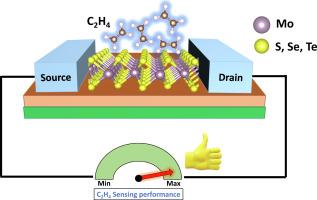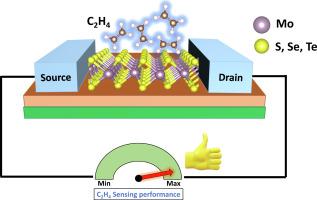基于钼基过渡金属二硫族化物的高效室温乙烯传感
IF 6.9
2区 材料科学
Q2 CHEMISTRY, PHYSICAL
引用次数: 0
摘要
检测乙烯(C2H4)在许多领域都是必不可少的,包括农业物流、水果质量控制、医疗保健和工业。然而,由于C2H4分子的非极性性质和对微量浓度(十亿分之一,ppb)的超高灵敏度要求,有效的C2H4传感面临着重大挑战。传统的C2H4传感器通常依赖于昂贵、复杂和不易携带的技术。在这项研究中,我们展示了二维(2D)钼基过渡金属二硫化物(TMDs)的潜力,包括MoS2, MoSe2, MoTe2,以及它们的缺陷/表面功能化形式,作为基于便携式电转导的有效C2H4传感器。采用密度泛函理论(DFT)、非平衡格林函数(NEGF)和Langmuir吸附模型热力学分析相结合的理论方法,探讨了上述材料的C2H4传感能力。我们的研究结果表明,原始TMDs对C2H4的吸附亲和力有限,但掺杂硅(Si)、锗(Ge)和锡(Sn)等元素显著增强了它们的吸附能力。具体来说,si掺杂的MoS2、ge掺杂的MoSe2和sn掺杂的MoTe2通过Si-C、Ge-C和Sn-C相互作用与C2H4表现出强烈的共价键,触发C2H4暴露后电子输运的对比调制。其中,si掺杂的MoS2表现出出色的灵敏度,能够在环境温度下检测ppb水平的C2H4。它的灵敏度为77.9% %,在500.0 K下的超快恢复时间为3.79 × 10−2 ms,使其成为高级c2h4传感应用的主要候选者。本文章由计算机程序翻译,如有差异,请以英文原文为准。


Highly efficient room-temperature ethylene sensing with molybdenum based transition metal dichalcogenides
Detecting ethylene (C2H4) is essential across various domains, including agricultural logistics, fruit quality control, healthcare, and industry. However, effective C2H4 sensing poses significant challenges due to the molecule’s non-polar nature and the requirement for ultra-high sensitivity at trace concentrations (parts-per-billion, ppb). Traditional C2H4 sensors often rely on costly, complex, and less portable techniques. In this study, we demonstrate the potential of two-dimensional (2D) molybdenum-based transition metal dichalcogenides (TMDs), including MoS2, MoSe2, MoTe2, and their defective/surface-functionalized forms, as effective C2H4 sensors based on portable electrical transduction. Using a combination of theoretical approaches, including density functional theory (DFT), non-equilibrium Green’s functions (NEGF), and thermodynamics analysis by Langmuir adsorption model, we explore the C2H4 sensing capabilities of the mentioned materials. Our findings indicate that pristine TMDs show limited adsorption affinity toward C2H4, but doping with elements such as silicon (Si), germanium (Ge), and tin (Sn) remarkably magnifies their adsorption. Specifically, Si-doped MoS2, Ge-doped MoSe2, and Sn-doped MoTe2 exhibit strong covalent bonding with C2H4 through Si-C, Ge-C, and Sn-C interactions, triggering contrastive modulation of electronic transport upon C2H4 exposure. Among these, Si-doped MoS2 demonstrates outstanding sensitivity and is capable of detecting C2H4 at ppb levels under ambient temperatures. It achieves a sensitivity of 77.9 % with an ultrafast recovery time of 3.79 × 10−2 ms at 500.0 K, making it a prime candidate for advanced C2H4-sensing applications.
求助全文
通过发布文献求助,成功后即可免费获取论文全文。
去求助
来源期刊

Applied Surface Science
工程技术-材料科学:膜
CiteScore
12.50
自引率
7.50%
发文量
3393
审稿时长
67 days
期刊介绍:
Applied Surface Science covers topics contributing to a better understanding of surfaces, interfaces, nanostructures and their applications. The journal is concerned with scientific research on the atomic and molecular level of material properties determined with specific surface analytical techniques and/or computational methods, as well as the processing of such structures.
 求助内容:
求助内容: 应助结果提醒方式:
应助结果提醒方式:


